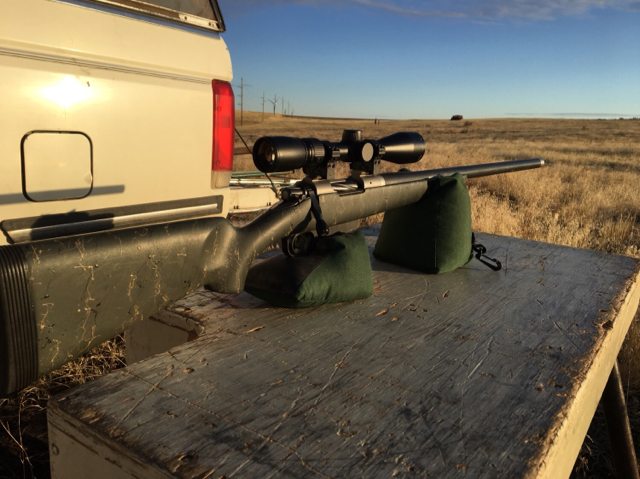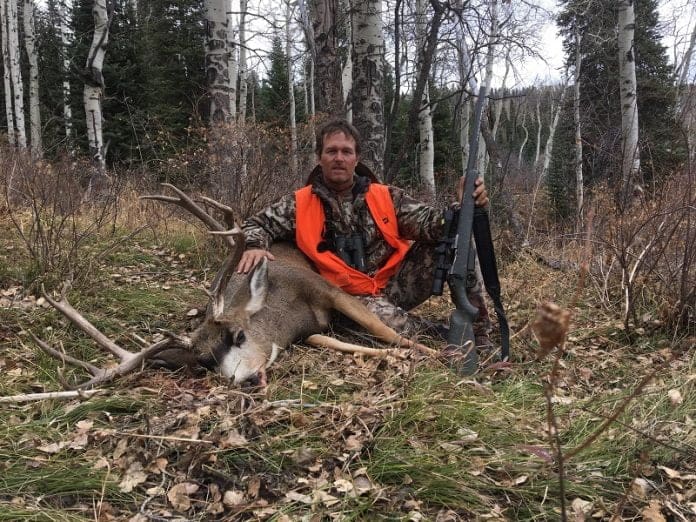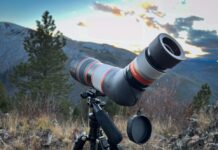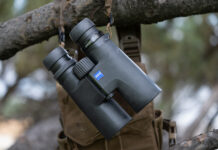 Vortex Razor HD Light Hunter 2-10×40 Riflescope Review
Vortex Razor HD Light Hunter 2-10×40 Riflescope Review
By Robby Denning, Rokslide Editor
Vortex released their HD Light Hunter (LH) riflescope line in 2016. Marrying their top glass from the Razor lines with a lightweight simple scope design, they’ve answered the call of the backcountry hunter who wants bright & light precision glass for today’s lighter rifles. There are three scopes offered in the line.
I previously reviewed the HD LH 1.5-8×32 here. At 13.4 oz. and 11” in length, it is the lightest scope in the line and is perhaps the ultimate muzzleloader or centerfire scope for hunters focusing on dense cover. Fellow Rokslide writer Jared Bloomgren reviewed the HD LH 3-15×42 here. At 16.5 oz. and 13.5”, this scope is better suited for the rifleman wanting to stretch the distance and is willing to carry a few more ounces for the opportunity. Both scopes reviewed well.
At 15.4 ozs. and 12.5”, the HD LH 2-10×40 fills the middle ground in the line—low enough power for hunting denser woods but with enough magnification for more moderate yardages, say out to 600. When the chance arrived to review the final optic in the line, I jumped at the opportunity. Mark Boardman, Head of Marketing for Vortex, generously comped me a 2-10×40 for my 2017 season. Like the previous LH, I could see this Razor glass offers optical performance that crowds the top-tier European scopes, but at a price many more of us could swing.
 As I said a few years ago in my article “Hash Marks or Turrets” I think anyone wanting to add a few hundred yards to traditional hunting distances while keeping a simple fast-aiming system atop a lightweight rifle, these mid-range capped turret scopes are the answer. Combined with Vortex’s BDC reticle, a hunter can enjoy a precise, quick aiming system well suited to hunting the North American continent, and the world.
As I said a few years ago in my article “Hash Marks or Turrets” I think anyone wanting to add a few hundred yards to traditional hunting distances while keeping a simple fast-aiming system atop a lightweight rifle, these mid-range capped turret scopes are the answer. Combined with Vortex’s BDC reticle, a hunter can enjoy a precise, quick aiming system well suited to hunting the North American continent, and the world.
Features & Benefits
A single piece, aircraft grade aluminum houses the High-Density (HD) extra low dispersion glass producing a bright and clear sight picture. I tested its brightness on a cloudy October day while still-hunting creek bottoms in Colorado against my Swarovski 8×42 EL binoculars. By shutting my left eye and looking at several objects out to a few hundred yards through the binos, then quickly switching to the LH, I put the LH slightly brighter than the ELs. That is by no means a scientific test but told me enough to know that the LH lets plenty of light through.

There are two reticles available in this LH line: the HSR-4 MOA and the G4 MOA. Like my 1.5-8×32 testing, I chose the G4. The G4 features five subtensions (hash marks), including the aim dot and top of bottom post, in a simple sight picture that can save critical seconds in the field. The HSR-4 is a little more complicated but offers the shooter the option to utilize more ballistic information into his shot without having to go to open dialable turrets.

The LH features quarter-minute-of angle adjustments and better yet, they’re adjustable with fingers! This feature saves looking for a coin or screwdriver (not to mention errant screwdrivers scratching your new scope). See the short video here
All the LH scopes offer a generous 3.8” of eye relief making them a good choice for hard-hitting magnums where scope bite is a real possibility.

To keep the LH light, the line is available only in 1” tubes (versus the larger 30mm.) Since these are not dialable open turret scopes, the loss of some MOA would not be an issue for the intended users. The downside with 1” tubes is that lightweight scope mounts are becoming rarer for this system. That’s counter-intuitive to me as lighter rifles are all the rage, but until the masses realize they don’t need 1,000-yard guns to fill their tags, expect a diminished selection of scope mounts for the 1” tubes.
Argon purging combined with O-ring seals creates a fog and moisture proof scope, but if you breathe on the lenses in cold weather, you’ll still get exterior fogging like all scopes—know the difference! The ArmorTek coating protects the exterior lenses from oil, dirt, and abrasive contacts.

Like its smaller cousin, parallax is fixed at 100 yards. In my testing, I found no noticeable parallax error in this scope. Vortex does offer parallax adjustment from 20 yards to infinity in the HD LH 3-15×42.
The LH line is backed by Vortex’s world class no fault warranty—no questions asked. Of course, we’d expect that, but an on-the-hunt scope failure is still a potential season-ender. Take heart that in the three seasons of packing multiple Vortex scopes, I’ve never had a single issue—that gives me more confidence than any warranty.
Mount Up
I pulled the Vortex Viper 3-9×42 I’d trusted for the 2015 and 2016 seasons from my Christensen Arms Summit Ti in 270 WSM, my go-to rifle for mule deer. Using Tally medium-height rings, I installed the new LH on the split picatinny rails.

Scoped, the rifle now registered at 7lbs 9 ozs—little weight for a lot of performance. I could have saved some more weight with Tally’s low-height, but the rifle’s weak spot is the 90-degree bolt throw. This limits how low I can go with a scope due to bolt interference. The medium-height mounts gave me enough clearance, even with hinge-style scope covers.

Range Time
I hit the range in late August. With a simple bore sight at 25 yards, then moving to 100, I had the gun zeroed in three total shots! Short video here
After the gun was zeroed, I wanted to try a new load. Working with some of Rokslide’s most knowledgeable members, including Mike Johnson of Hells Canyon Armory, I landed on the new 140 grain Berger Classic Hunter fueled by 67 grains of RL-26. This load clocked in near 3,400 fps and punched multiple sub-MOA groups. You can follow that load development and pick up some valuable reloading tips here


I used Vortex’s Long Range Ballistic Calculator (LRBC) to estimate my hash mark’s predicted POI, and then checked the predictions at the range (never skip that step.) This was the first time in three Vortex scopes that the calculator didn’t predict to the yard my POI. I called Vortex and found out the LH’s second hash mark is set at 2MOA, but the LRBC is set at 1.5. I corrected for that and in one more range session, had my hash marks confirmed:
Center dot- 200 yards
2nd hash (top of thin post)- 310 yards, (rounded to 300 on my dope sticker)
3rd hash- 420 yards
4th hash- 550 yards
5th hash, top of heavy post- 685 yards (I did not confirm this yardage as I won’t hunt that far at this point in my hunting career)
To note, I also checked at 100 yards to find I was less than 1” high—attesting to the flat shooting 270 WSM.
I don’t like to place my dope sticker in my scope covers, as I don’t use them in dry weather. I made a simple waterproof sticker and taped it to the front bell where I could see it without lifting my head too much. After just a few days packing, I’d memorized the distances and didn’t even need to look when the action finally heated up.
The Hunts
I started hunting with the HD LH 2-10×40 in Idaho’s early October season. Although the fruitless days stacked up, the new LH proved its brightness, clarity, and packability even more. I’m not a he-man hiker, but I do walk two to four miles per day on average, even when using horses. Add in that I still-hunt most days—where your gun stays in your hands ready for action—I was really appreciating the light rifle/scope system.
The third week of October found me 600 miles from home hunting public land on Colorado’s Western Slope. It was second deer season—arguably the toughest season to kill a big mule deer on. I hunted from 10.5K to 7.5K feet over the course of eight days. Hunting was slow, but I was seeing nice bucks most days, usually near the cover. On day six, I’d glassed a fairly good buck and decided if I hadn’t seen anything better in the next few days, I’d try for him.
 Two slow days later, I crept around the edge of the last quakie pocket where I’d seen him. It was around 10:00 AM when I heard a deer blow below me. I glassed into the heavy cover and saw a mature 3×4 buck turn and melt into the tangle. Bucks are rarely alone, so I trotted around the edge of the quakie pocket to see if I could cut him off, and cut him off I did. Better yet, the bigger buck I’d hoped for was with him. While at less than 100 yards, they’d seen and heard me and were chewing up the real estate faster than a Saturday night drag race.
Two slow days later, I crept around the edge of the last quakie pocket where I’d seen him. It was around 10:00 AM when I heard a deer blow below me. I glassed into the heavy cover and saw a mature 3×4 buck turn and melt into the tangle. Bucks are rarely alone, so I trotted around the edge of the quakie pocket to see if I could cut him off, and cut him off I did. Better yet, the bigger buck I’d hoped for was with him. While at less than 100 yards, they’d seen and heard me and were chewing up the real estate faster than a Saturday night drag race.
I yanked the rifle from my shoulder and flipped the safety off. In the commotion I accidentally fired before I was even aiming at the buck (amateur move, I know). They really kicked it in gear at the “warning” shot and I now only had a few seconds. I got the LH center dot on the biggest buck’s neck as he headed straight away at nearly full speed—BOOM! Clean miss…
I cycled another round and followed him through the ever-deepening tangle of brush until he hit a small opening and slowed to change directions. That was all I needed. The G4 dot hit his shoulder and he was down at 120 yards. The quick aiming reticle was just what I needed for this job. That was the 28th of October.

By November 2nd, I was on the hunt again, this time in my home state of Idaho and hunting private land. The rut was kicking in so I spent the mornings taking inventory of various doe groups, and the evenings still-hunting/ambush hunting near those same deer. I kept this up for seven days hunting for the best buck possible. By the evening of the last day, I’d resigned myself to going home empty.
With only 40 minutes of legal light left, I turned the 15x Swarovski’s to a hillside over a mile distant. I knew I was crazy glassing that far away with so little light left…and wouldn’t you know it—there was a shooter buck courting does. I tore off the knob, mounted my saddle horse Leo and did the Billy-the-Kid through the thick creek bottoms. Luckily the cover hid my movement as we headed towards the rutting buck (God must like to watch this stuff as I end up in these frantic situations all too often).
I tied off quickly and sprinted about 100 yards hoping the buck was still there. He was! The range was around 430 yards. His does had heard me coming and started to move away, pulling the buck with them. I knew I had to make this happen NOW.
I cranked the scope to full power and lay down, still breathing hard from the sprint. I quickly found him and put my 420-yard hash mark on his shoulder and waited for him to stop. He did but with no bottom butt support on the stock, I pulled the shot. All the deer disappeared into the thick serviceberry brush. With not much to lose, I scrambled forward about 100 yards while they were hidden. They appeared higher on the hill and were now around 300 yards in the fading light. It was then that I recognized the buck as a nice one I’d passed up the previous day—nothing like a last chance at last light on the last day!
I was already prone and ready when they paused where I could see him clearly. I settled the 2nd hash mark on his vitals and held it there until the rifle recoiled. The shot killed him almost instantly, and with only about 15 minutes of shooting light left. I was at least a little shocked at what had just happened in the waning moments of my 2017 season.

Both these stories illustrate why I prefer lightweight rifles, with fast and accurate aiming systems. In both cases, I only had seconds to shoot and quick follow up shots were necessary.
 The only downsides I found during this review are the hash marks are little light for my 48-year-old eyes. I can still see them, but a few years from now, I might need bolder hash marks. Also, the LRBC needs to have the option for the G4 reticle; it’s just too good to ignore.
The only downsides I found during this review are the hash marks are little light for my 48-year-old eyes. I can still see them, but a few years from now, I might need bolder hash marks. Also, the LRBC needs to have the option for the G4 reticle; it’s just too good to ignore.
For the way I hunt, the Vortex HD LH scopes offer the most benefits. If you’re into light rifles and probably will never shoot beyond 600 yards, give the HD LH 2-10×40 Vortex Razor a gander. I’m pretty sure you’ll see the light.

You can ask Robby questions or comment on this article here




















